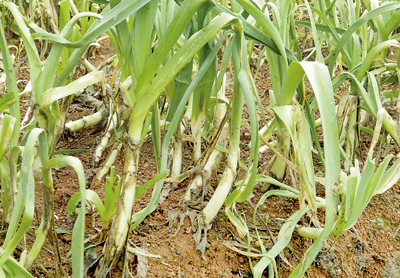News
Monsoon rains intensifying over time
Monsoon rains have clearly increased in intensity, experts said, as continuing bad weather damaged at least 132 houses and causing a death – and the government warned that the economy would be a victim of our changed weather patterns. The country experienced heavy flooding in 2011 and 2010. Prolonged drought affected 2012, and floods returned over the past few months of this year. The resulting damage has not only affected agriculture and livelihoods but also infrastructure.

Vegetable plantations have been badly affected in Nuwara Eliya
Treasury Deputy Secretary Dr. Suren Batagoda said recent changes in weather patterns had caused billions in losses. “Newly done roads and bridges were damaged due to the unexpected and intense rainfall. The Treasury had to allocate Rs. 60 billion for flood control and flood damage in 2010 and 2011,” he said.
“In 2012, due to drought we could only produce 18 per cent of electricity through hydro-power. Using fuel to generate electricity is expensive, so this has become an additional burden to the economy,” Dr. Batagoda added.
The Deputy Secretary of Treasury made these revelations last week delivering the keynote address at the Symposium on Community-Based Adaptation to Climate Change, organised by the Global Environmental Facility’s Small Grants Programme (GEF/SGP) of UNDP with support from AusAid.
Other climatic experts addressing the symposium also stressed that frequent weather-related disasters and climate change could seriously set back development targets set for key sectors such as agriculture, fisheries and even services such as tourism.
Most infrastructure projects, including roads, drainage systems, railways, etc. have not been factored in weather change considerations, the National Climate Adaptation Strategy of Sri Lanka (NCASS) emphasised in a recent report: “While in some areas it may not matter, in others this is critical”.
“Transport infrastructure in certain coastal areas could be under severe threat due to sea level rise. A systematic investment program to adapt infrastructure prone to weather change risks is not available and this will necessarily have to follow after a detailed study, but the investments involved could be substantial. However, incorporating these additional elements to face risks of weather change impacts is important as otherwise, the whole investment will go in the water,” the report points out.
The impact of weather changes on agriculture is evident in the hill country. Nuwara Eliya and its suburbs have been experiencing gloomy weather since April, with some areas receiving doubled rainfall. This has badly affected the tea yield, where some of the estates are recording losses in millions of rupees.
“The tea bushes in hill country have not received enough sunlight so they are not producing buds at the normal rate. Some estates that pluck buds once a week have had to wait more than two weeks and even then those buds are not up to the usual yield,” revealed Dr. Wijeratne of the Tea Research Institute. “This kind of bad weather is not (so far) prolonged in the hill country but these abnormal weather patterns could be indicating a changing climate,” he said.
Between 1974-2008, the highest number of people affected was due to floods and the next highest number of people affected has been due to drought, according to statistics contained in the Sri Lanka Disaster Profile. Compensation is an additional burden to the economy. Preparedness will be a key to face a future disaster.
Grim warning from ‘Himalayan tsunami’
By Malaka Rodrigo
A few weeks ago, the Himalayan region faced a flood so devastating it was called Himalaya’s Tsunami. TV footage showed horrific images of large buildings being washed off hillsides by the floods. The official death toll topped 1000 but it is believed to be many times that as the number of people missing is high and rescue attempts are still being carried out in remote regions.
The Uttarakhand disaster was the result of extreme rains and haphazard development, Indian environmentalists said. The area received unusually high rainfall, causing rivers to swell. India’s Centre for Science and Environment (CSE), in its journal Down-to-Earth, states, “The area has been denuded to a great extent due to deforestation and tree cutting for road construction, and other activities such as building construction, mining and hydro power projects. It has also resulted in increased surface flow and rise of river bed due to disposal of debris in the rivers.”
Some areas in Uttarakhand received more than 400 per cent of usual rainfall. What if Sri Lanka received such rainfall?
Watawala was flooded in May for the first time in recent history, so the possibility of floods in Sri Lanka’s own hill country is not remote. Centre for Environmental Justice spokesman Hemantha Withanage says such a situation would spell great danger. “We have cut down trees even on slopes of the mountains. Unplanned developments are being carried out in the area which has doubled the risk of landslides,” he pointed out.
The report on the Uttarakhand floods stated that the “floods turned into a major disaster when people, along with their properties and infrastructure, occupied such areas without adequate information, knowledge, awareness and preparedness against the potential disaster”. This could also be a lesson for Sri Lanka too. Disaster Management Centre (DMC) Media Deputy Director, Lal Sarath Kumara, pointed out that the intensity of rains created floods unexpectedly in many areas. In March, for example, the Deduru Oya flooded areas from Kurunegala to Chilaw after more than 100 years.
Mr Kumara said the DMC was ready for any eventuality and that a network of district-level regional centres had been set up with village-level disaster relief committees. If there were signs of a sudden disaster such as floods, the information would be passed to these regional units to take necessary action.
Follow @timesonlinelk
comments powered by Disqus

